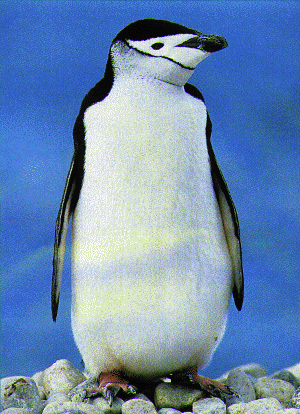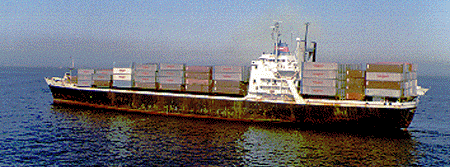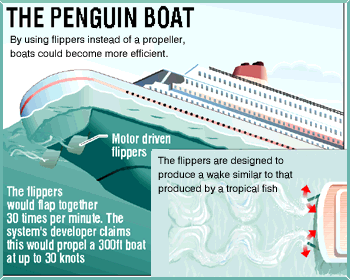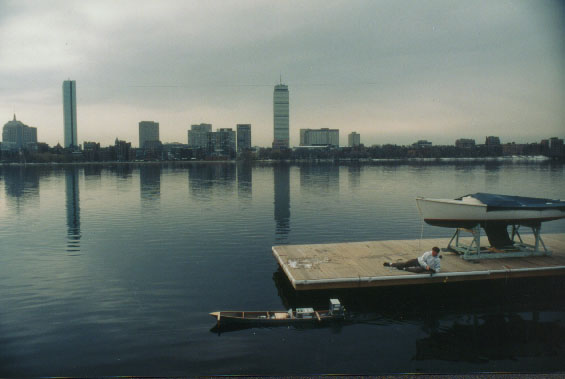 |
Penguin Power Page |
 |
 |
Penguin Power Page |
 |
'Penguin Power' Propels the Navy
Business Week 12 May 1997 Page 107 "Developments to Watch" section
by Paul C. Judge
Engineers have tried for more than a century to improve on the simple but inefficient ship's propeller. The latest effort is based on penguin flippers. Massachusetts Institute of Technology researchers have built a propulsion system that utilized two oscillating blades that produce thrust by sweeping back and forth in opposite directions.
A 12-foot scale model of the "penguin boat" has shown promise in early lab trials. The blades achieved about 87% efficiency, compared with 70% in conventional ships - which translates into lower fuel consumption. MIT researchers calculate that converting only 3% of the U.S. shipping fleet to a propulsion system that increases efficiency by just 10% would save some $15 million per year.
Based on laboratory results, MIT's penguin boat is capable of moving as fast as conventional propeller driven craft - and it may be easier to maneuver. All this information interests the U.S. Navy, which supports the project through the Office of Naval Research.
PROTEUS THE PENGUIN BOAT
Source: MIT web site


 And you get a boat that swims like a fish. Just as a penguin or sea
turtle are a rigid body with fish-like flapping fins, Proteus is a boat that
propels itself with two oscillating foils.
And you get a boat that swims like a fish. Just as a penguin or sea
turtle are a rigid body with fish-like flapping fins, Proteus is a boat that
propels itself with two oscillating foils. The Proteus project is the challenge of pragmatically applying highly efficient natural fish propulsion technologies to conventional vessels.
One hundred and fifty million years of evolution has enabled fish to develop extremely efficient technologies for aquatic propulsion and maneuvering. Recent experimental, MIT Robo-tuna, and computational studies confirmed this. However, because these studies were based on models with undulating bodies, direct application to ships and submarines is not possible. Our goal was to apply the promising "fish" technologies to conventional marine vessels pragmatically.
Success could mean the savings of millions of marine transport dollars and subsequent environmental damage, autonomous ocean research vessels covering more territory, and military submarines evading their foe because their "fish wake" is difficult to detect. An extensive literature review and discussions with marine hydrodynamics experts showed that efficient propulsion may be obtained by the oscillation of a foil without an undulating body. For example, large whales and other oscillating foil propelled animals requiring high efficiency employ the thunniform mode of swimming, which consists primarily of tail oscillation. Other animals, such as marine turtles or penguins, obtain efficient propulsion by pectoral flipper oscillation alone.
In this spirit, a boat foil propulsion design was developed with two foils moving out of phase so that thrust would be the only net force and vertical foil orientation allowing for the possibility of thrust maneuvering with thrust vectoring. The challenge of actuating the foils with the appropriate "fish" motion was first met with a prototype mechanical device capable of oscillating two foils with limited independent adjustment of the foil's heave, pitch, frequency and phase between the motions. First-ever autonomous operation and wake visualization experiments were conducted and yielded useful results. The shortcomings of the first mechanism where met with a remote controlled four-degree of freedom robotic mechanism. Advanced mechanical design and state of the art electronics allow this 3.4 meter long oscillating foil propelled boat to produce accurate efficiency measurements over a wide range of operating parameters. Results from preliminary experiments are very encouraging.

Proteus the Penguin Boat in the News
Source: MIT web site


MIT 'Penguin Boat' Takes Maiden Voyage Down Charles River
Breif
Source: MIT web site
![[penguin boat]](../../../artwork/penguin/pengboat.gif)
Proteus, a "penguin boat" developed by graduate student James Czarnowski and inspired by "Robotuna," is propelled by two flipper-like oscillating foils (at right). Photo by Donna Coveney, MIT News Office.
![[penguin boat charles river]](../../../artwork/penguin/pengchas.gif)
Proteus, an experimental 'penguin boat' propelled by oscillating foils, moves down the Charles River in front of the Boston skyline during an early-morning test run. Photo by Donna Coveney, MIT News Office.
04/03/97 MIT 'Penguin Boat' Takes Maiden Voyage Down Charles River
News Office
MIT News Office
Massachusetts Institute of Technology
Room 5-111
77 Massachusetts Avenue
Cambridge, MA 02139-4307
Phone: 617-253-2700
NOTE: PHOTOS AVAILABLE.
================================
MIT's `penguin boat' takes
maiden voyage down Charles River
================================
New propulsion system could lead to more efficient ships
For Immediate Release, April 3, 1997
Contact: Elizabeth A. Thomson
Phone: (617) 258-5402
Fax: (617) 258-8762
E-mail: <thomson@mit.edu>
CAMBRIDGE, Mass--Zipping along through the water, the penguin uses two
flippers to propel its rigid body quickly and efficiently. Now MIT
engineers have applied that "technology" to a man-made vehicle that
recently took its maiden voyage down a short stretch of the Charles
River.
Introducing Proteus the Penguin Boat, a 12-foot craft with two
"oscillating foils," or flippers, attached to its stern. Named after the
son of the sea god Poseidon, Proteus could lead to full-scale ships that
move more efficiently--and consume less fuel--than those using
traditional propellers. (An experimental model, Proteus is too narrow to
fit even a single passenger.)
The boat is the first of its kind. In the past researchers have
performed theoretical computations for propelling a boat with flippers,
but until now no-one had built one.
Preliminary tests are promising. The new propulsion system when
tested in the laboratory reached up to 87 percent efficiency. The system
as implemented on the boat "is still being evaluated since many of the
components are novel and require further development," said Michael S.
Triantafyllou, a professor in the Department of Ocean Engineering who
leads the research team. Professor Triantafyllou noted that the average
efficiency of existing ships is at or below about 70 percent.
According to 1992 US Fuel and Shipping Statistics, "converting only
three percent of the United States shipping fleet to a propulsor with 10
percent higher efficiency would mean an [annual] monetary savings of $15
million and 120 million fewer liters of petroleum fuel being burned,"
wrote James T. Czarnowski, a graduate student in the Departments of
Ocean Engineering and Mechanical Engineering, in a paper he and two MIT
undergraduates will be presenting on the work at the May 1997
International Society of Offshore and Polar Engineers (ISOPE)
conference.
FISH-LIKE PREDECESSOR
Proteus is a direct descendant of robotuna, another biologically
inspired MIT creation. This four-foot-long robotic fish, patterned after
a bluefin tuna, was designed to test the efficiency of a single
oscillating foil--a fish's tail. That efficiency proved to be about 85
percent, under conditions of developing the amount of force required
normally by marine vehicles, and in 1995 MIT was awarded a patent on the
propulsion mechanism.
"The experimental work on the robotuna foil showed high efficiency
and high promise. So the next focus was to give it a real-life
application," said Professor Triantafyllou.
But ships patterned after the robotuna itself, whose entire body
swishes back and forth as it moves through the water, aren't practical.
"We thought that if we could remove the body and just keep the tail, we
could take a lot of the good from the tuna without the need to have the
undulating body," Mr. Czarnowski said.
conducting a feasibility study, Mr. Czarnowski spent six months building
a six-foot prototype. The device showed enough promise that Professor
Triantafyllou gave the go-ahead to develop a more advanced version.
Among other things, when the engineers studied the wake of the
prototype they found that it closely resembled the wakes of the robotuna
and of living tropical fish (Danios). "That was important because it
showed us that with two flippers we were producing the same
hydrodynamics that a fish tail produces and therefore we should see
As with the robotuna, Nature also helped the engineers with the new
design. "Penguins and sea turtles are the biological analogies to what
we were looking for," Mr. Czarnowski explained. "Both have rigid bodies
like a boat, and propulsion is achieved through oscillation of pectoral
flippers."
After videotaping penguins at the New England Aquarium and
similar efficiencies," Mr. Czarnowski said.
So a little over a year later, Mr. Czarnowski, Professor
Triantafyllou, and colleagues produced Proteus. The multidisciplinary
team included three undergraduates: Timothy R. Cleary, a senior in the
Department of Aeronautics and Astronautics; William R. Kreamer, a junior
in the Department of Ocean Engineering, and Michael C. Murphy, a senior
in the Department of Electrical Engineering and Computer Science.
Czarnowski, Cleary, and Kreamer will be presenting the work at the ISOPE
conference.
Proteus allows the researchers to study a wider range of flipper
motions than the prototype was capable of, and also allows them to more
accurately measure the propulsion mechanism's efficiency. "The prototype
was entirely mechanical and was built using 19th-century technology,"
Mr. Czarnowski explained, "whereas Proteus uses state-of-the-art
robotics. It's also twice as big, so we can measure larger forces and
have a wake that's easier to visualize."
The boat, which is about 1 1/2 feet wide by 12 feet long, is a
scale model of a fast ship. Packed inside are two car batteries, a 486
desktop computer, a power-sensing circuit, and a voltage converter that
changes the battery power into the power used by the computer and by the
four motors that control the motion of the flippers. Two large motors
allow the flippers to move toward and away from each other; two smaller
motors allow them to twist slightly as they do so.
Before the researchers send the boat for a run down the Charles
River, they program it for a specific "flapping motion" of the flippers.
These commands are relayed to the onboard computer via a monitor and
keyboard that are then disconnected from the computer and remain on the
shore. Once Proteus begins moving through the water it is controlled by
a remote control. The same remote control also allows the researchers to
start recording (via the onboard computer) how much power the motors are
using. That data, in turn, allows them to calculate the efficiency of
each run.
"Once we determine the most efficient flapping motion on the
Charles," said Mr. Czarnowski, "we want to bring the boat back to the
MIT Testing Tank to study the wake so we know what an efficient wake
looks like."
Future work includes designing a flipper system that allows for
maneuvering as well as propulsion. Currently Proteus can only move in a
straight line. As a result, for tests on the Charles the boat is
attached via two guides on its left to a long string of fishing line
that in turn is strung between two piers. Once it has completed a run
from one pier to the other, one of the researchers hauls it back to the
"start" with a fishing pole.
A LOVE FOR BOATS
Jim Czarnowski has always loved boats. "I've been building strange
little boats like this since I was eight years old," he said. "My first
one was a papier-mache paddle-wheel boat with a small electric motor
that powered a popsicle-stick paddle wheel. Now that I'm at MIT I can
build more advanced models."
What's been the best part of the Proteus project? "Finally seeing
it work, and having everyone who's worked so hard on it enjoying that
success as well," Mr. Czarnowski said.
He also likes sharing the excitement with others. Every test on the
Charles has drawn an audience, even though those tests at the MIT
Sailing Pavilion begin at about 5:30 in the morning to take advantage of
the calm conditions on the river. "Seeing their curiosity and explaining
to them what we are doing is very rewarding," he said.
The work is supported by the Office of Naval Research and the MIT
Sea Grant College Program.

Return to Recreational Boat Building Industry Home Page